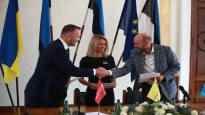The new government of Kaja Kallas will keep Estonia’s foreign policy unchanged, but shake up domestic politics. For example, teaching in Russian will be abolished and gun permits will be taken away from Russian citizens.
TALLINN Estonia drifted into a government crisis at the turn of May and June, when the Center Party began to consciously act against its government partner, the Reform Party.
Among other things, the center together with the opposition pushed for significant increases in family benefits. At the same time, it torpedoed the reform party’s initiative to abolish Russian-language education.
The background was the center’s concern about its poor, roughly 15 percent support nine months before the parliamentary elections. At the same time, the Reform Party’s support reached a peak of 32 percent.
Today, the Riigikogu, the Estonian parliament, gave Kallas the authority to form a new government. In addition to the liberal reform party, the conservative Isänmaa and the social democrats are joining it.
We listed five significant changes in Estonian politics.
1. Different value bases are mixed in the board
Combining liberal, conservative and social democratic values is not easy. The government’s program is necessarily a compromise, where everyone loses somewhat and everyone wins something.
– The agreement is good when no one is completely satisfied, commented Kallas on the government program a week ago.
For example, the Reform Party had to swallow its reluctance regarding increases in family benefits. The basic part of the child allowance will rise from 60 euros to 80 euros. The supplement paid to families with at least three children will rise from 300-400 euros to 600-800 euros.
However, this is less than Isänmaa and the Social Democrats would have hoped for. Even so, increases in family benefits increase government spending by more than one hundred million euros per year.
2. Estonia gives up teaching in Russian
In Estonia, both primary education and secondary education are also taught in Russian. Teaching in Russian is now coming to an end.
The conversion of Russian-speaking kindergartens and schools into Estonian will begin in 2024.
– By 2030, all teaching will be in the Estonian language, Minister of Finance Keit Pentus-Rosimannus stated after the governing parties reached a consensus.
Here, too, a compromise had to be found. The argument between the Fatherland and the Social Democrats about the details of the reform got heated at times.
3. An ambitious environmental program
At the core of the new government’s environmental program is renewable energy, especially wind power.
– We are aiming for carbon neutrality in electricity production by 2030, Prime Minister Kallas told the Riigikogu today.
Until now, the construction of wind farms in Estonia has often been held back by the rigidity of the planning process and the opposition of local residents. Medicines are promised for both in the government program.
It is intended to pay substantial damages to local communities. Improvements promoting wind power are promised for zoning and the planning and permit procedure.
4. The residence permits of citizens of Russia and Belarus are cancelled
About 80,000 Russian citizens live in Estonia. About 1,300 of them have received a gun permit.
At the beginning of March, the Estonian Gun Owners’ Association proposed to the Ministry of the Interior to cancel the gun licenses granted to citizens of Russia and Belarus.
– If Russia wanted to weaken Estonia’s internal security, it could use these gun owners for sabotage activities. In a war situation, they could be harnessed for enemy action, the union government pleaded.
The cancellation of weapons licenses was somewhat unexpectedly found in the program of the new Estonian government announced today. The subject was not previously discussed during the government negotiations.
5. Many first-timers among the ministers
A total of 15 ministers are joining Kaja Kallas’ new government. The government seats are divided equally among the three parties.
In addition to Kallas’ position as prime minister, the reform party retains, among other things, the positions of minister of state finance and minister of defense.
The Motherland will receive, among other things, the portfolios of the Minister of Justice, Foreign Affairs, and Education, and the ranks of the Social Democrats will include, among other things, a new Minister of the Interior and Minister of Labor and Health.
Six, or 40 percent, of the ministerial candidates are first-timers.
Especially the Isänmaa Party’s candidate for Minister of Justice Lea Danilson-Järg and a candidate for Minister of Business and IT Kristjan Järvan have spoken to Estonian experts.
– It seems that in Estonia, with a sufficiently thick wallet and consistency, you can buy both laws and ministerial positions, politika.guru comments on the choice of the duo.
Also the election of the Social Democrats as Minister of Health and Labour Peep Peterson has suspected Estonians. He is an experienced ay leader and as Minister of Labor he is believed to be competent. However, next fall and winter, the ministerial portfolio will require a lot of handling of corona-related health issues.
Instead, the ones who end up as defense ministers are experienced fighters Hanno Pevkurfuture foreign minister Urmas Reinsalu and the Minister of Education Tõnis Lukas.
Chairman of the Social Democrats Lauri Läänemets, a first-timer as well, is going to the government as interior minister. The leader of the fatherland Helir-Valdor Seeder did not want to be a minister instead.
The new ministers will be sworn in next Monday.
Kaja Kallas’ second government will be in power for just under eight months. Estonia will hold parliamentary elections in 2023 at the beginning of March.
